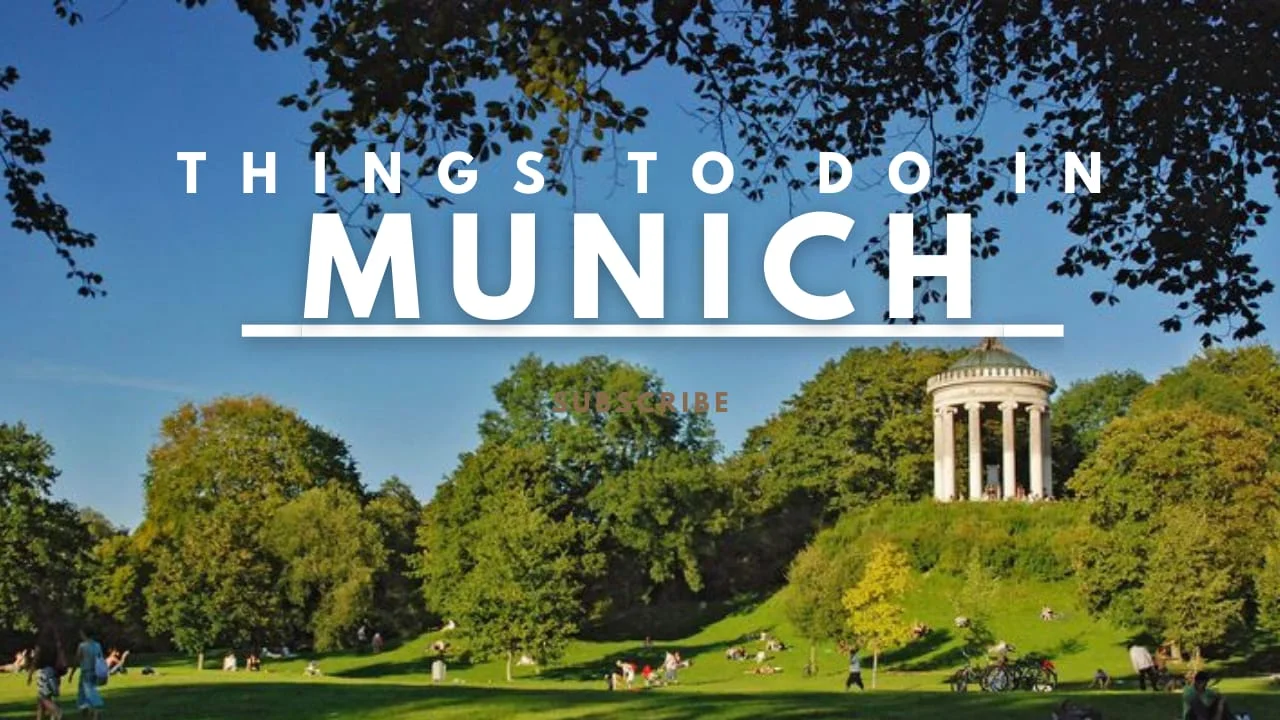Manich your Top Travel Destination
Munich is known for its beer gardens and beer halls, but the city offers much more. Beyond the beer-fueled attractions of Oktoberfest, Munich is a cosmopolitan city rich in culture. Art lovers will enjoy the variety of museums, including the Pinakothek art museums, Bavarian National Museum, and Deutsches Museum. Sports enthusiasts shouldn’t miss the FC Bayern Museum, a must-visit for soccer fans.
Even if you’re not here for Oktoberfest, Munich has plenty to offer. Enjoy sightseeing or take a bike tour through the famous English Garden. The city is perfect for a city break, with iconic city landmarks and cultural hotspots. Whether it’s beer tastings, holiday activities during the Christmas markets, or exploring local culture, there’s something for everyone. With three days, you’ll easily find time for tourist spots, outdoor activities, and unforgettable local experiences. Also read this Things To Do In Savannah, GA
Top things to do in Manich:
1.Marienplatz and Surroundings
The best ways to begin exploring Munich is by visiting Marienplatz, the heart of Munich. This square, easily accessible by the U-Bahn station, is where the city’s history comes alive. Marienplatz has been the city’s center since it was founded in 1158 and has witnessed medieval markets and jousting tournaments in its early days. Today, the square is busy with locals and tourists alike, and it’s a must-visit spot, especially for its two iconic town halls. Marienplatz serves as the perfect starting point for a tour around central attractions. It’s also near the Viktualienmarkt, a foodie paradise where you’ll find an endless selection of restaurants, cafes, and shops. During Christmastime, the square transforms with vendors selling festive food, mulled wine, and holiday gifts at the Christkindlmarkt, adding to the holiday season magic. Whether you’re here for the vibrant Christmas decorations or just to enjoy the lively atmosphere, Marienplatz is the heart of everything
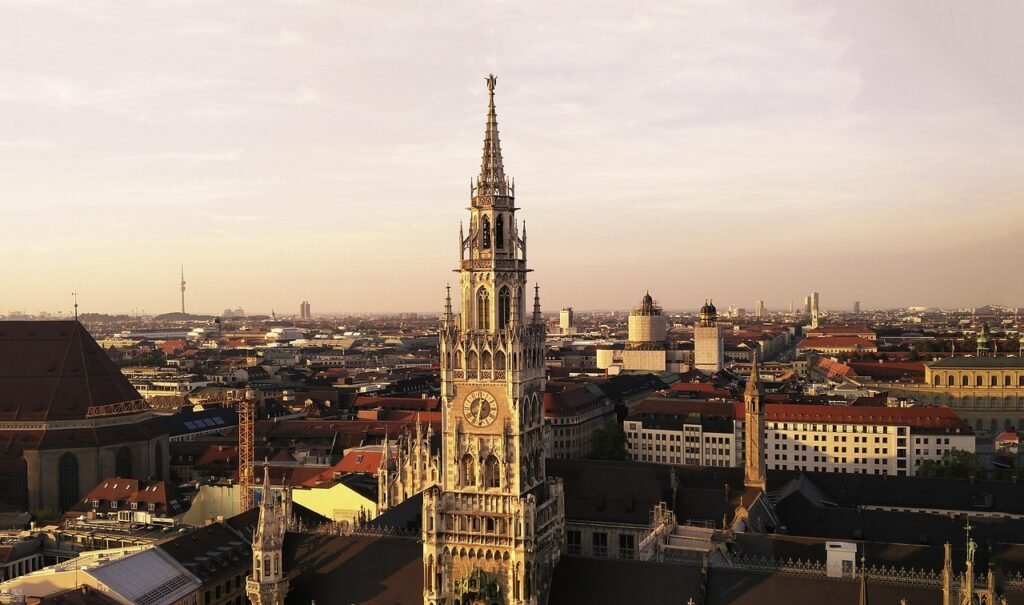
2.Englischer Garten
The Englischer Garten is a must-do in Munich, stretching from the city center to the northeastern city limits. This large public park is designed in the informal English style, featuring rolling hills and open landscaping. Inside, you’ll find four popular beer gardens, perfect for enjoying a cold drink while strolling along the jogging paths and biking paths. There are also many kiosks for drinks and snacks, and a boating lake to relax by. The park is home to unique monuments, including a Greek temple, a Japanese tea house, and the iconic Chinese Tower (Chinesischer Turm), which has one of the largest beer gardens in the city.
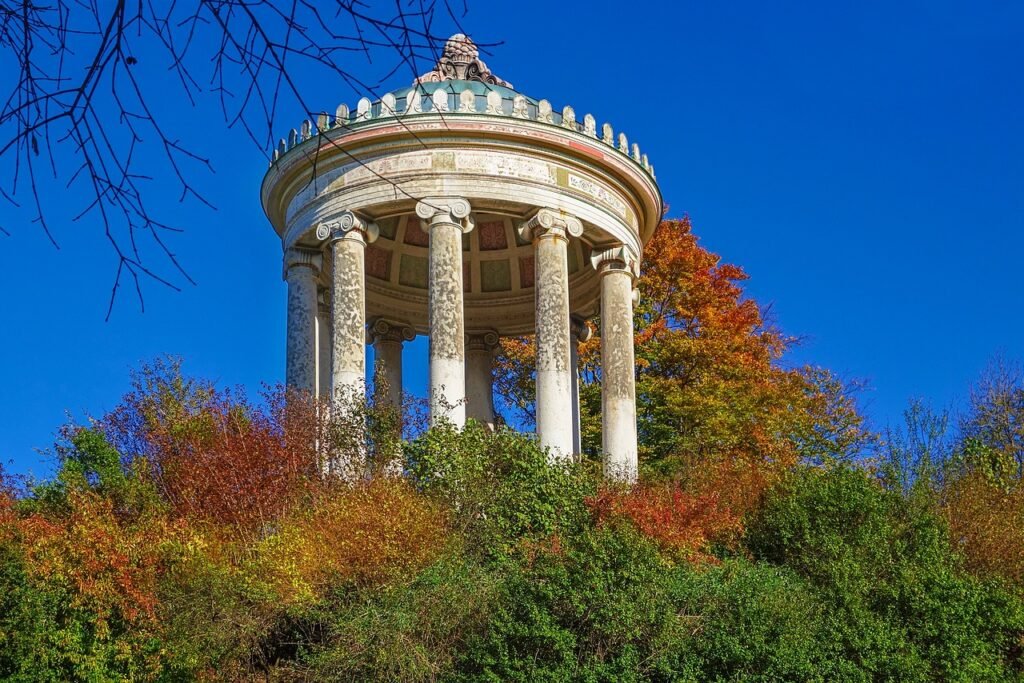
One of the park’s biggest attractions is the Eisbach wave (Eisbachwelle) at the garden entrance, a human-made standing wave perfect for river surfing. Whether you’re attending a Christmas market, enjoying seasonal events, or simply exploring, the Englischer Garten is a must-visit.
3. Munich Residence (Residenz München):
The Residence in Munich is a must-visit for anyone interested in history and art. Inside, explore more than 150 ornately decorated rooms filled with tapestries, paintings, sculptures, clocks, and furniture. A highlight is King Ludwig I’s neoclassical royal apartment, while the treasury comprises 10 halls displaying a magnificent collection of exhibits such as crowns, goblets, swords, jewelry, and tableware. Don’t miss the Court Church of All Saints (Allerheiligen-Hofkirche), the Rococo Cuvilliés Theater (Cuvilliés-Theater), and Hercules Hall (Herkulessaal), all used as performance venues.
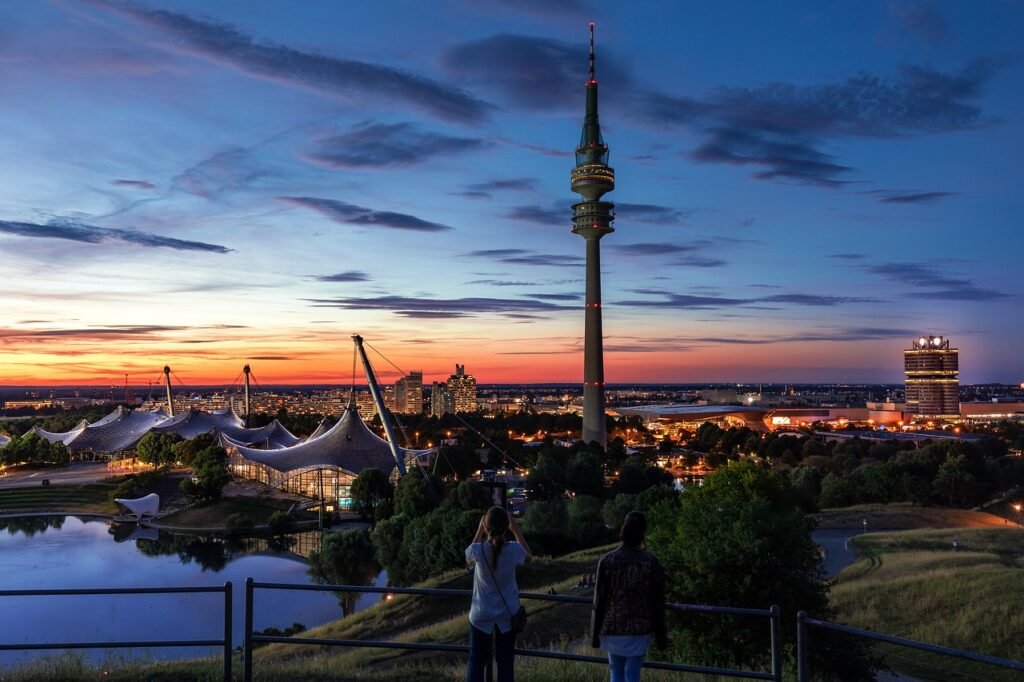
Surrounding the palace is the picturesque Court Garden (Hofgarden), a peaceful park with courtyards, fountains, statues, pavilions, and water features. Many travelers recommend buying a combined ticket for the Residence, Treasury, and Cuvilliés Theater. Reviewers suggest arriving early to avoid the crowds and make the most of your visit.
4.Nymphenburg Palace:
Located in the northwestern district of Neuhausen-Nymphenburg, Palace (Schloss Nymphenburg) was built as a gift for Elector Ferdinand Maria and Henriette Adelaide of Savoy on the birth of their long-awaited son. Designed by Italian architect Agostino Barelli, who also designed Munich’s Theatine Church (Theatinerkirche), the palace was completed in the 1670s in Baroque-style. Over the centuries, the palace was extended and embellished with Rococo and Neoclassical elements.
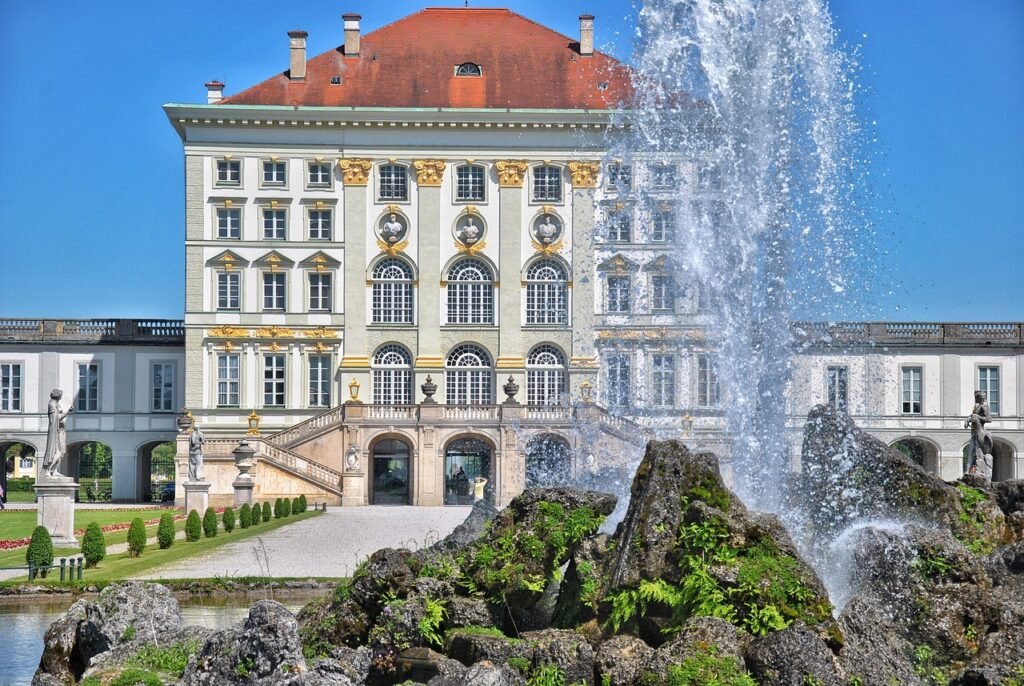
One of the most famous attractions is King Ludwig I’s Gallery of Beauties (Schönheitengalerie), which showcases over 30 portraits of beautiful women from the royal court and Munich’s upper classes. The Royal Stables Museum (Marstallmuseum) is another must-see, where you can admire more than 40 horse-drawn carriages, sleighs, and riding equipment owned by the Wittelsbach dynasty, who used Nymphenburg Palace as their summer residence.
5. Viktualienmarkt
The Viktualienmarkt, located off the Marienplatz U-Bahn and S-Bahn stops, originated as a farmers market in 1807. Today, the market features around 100 stands selling everything from freshly baked bread to sausages, honey, and fresh flowers. It also has several fountains with statues of local comedians, actors, and singers, along with a towering maypole decorated with emblems depicting various aspects of Munich life. For a relaxing break, enjoy a locally brewed beer under the chestnut trees in the Viktualienmarkt beer garden.
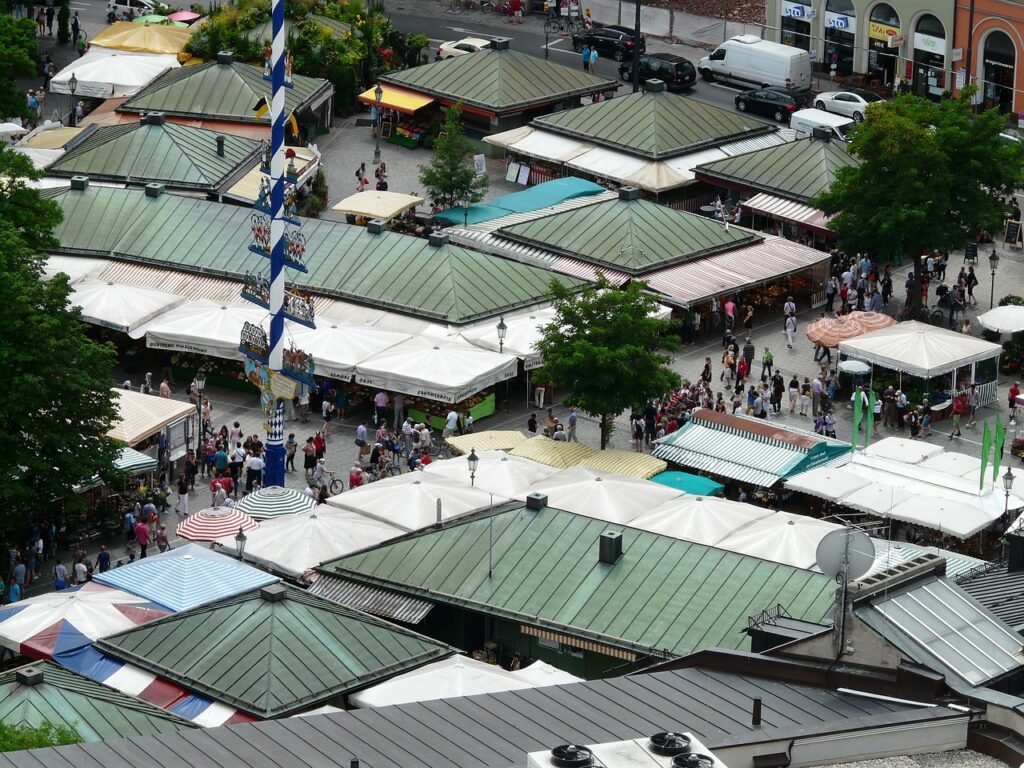
Travelers recommend the market for an enjoyable afternoon stroll, where you can buy and sample local goods, such as pretzels and white sausages. Many visitors also suggest finishing the day with a cold drink at the beer garden, making it the perfect way to experience the vibrant atmosphere of Munich.
6. Old Town (Altstadt):
Located in the heart of Munich, the Old Town (Altstadt) is a bustling area filled with activity, making it just as popular with tourists as with locals. It’s packed with sights and attractions, including Marienplatz, which sits at the center of the Old Town. This historic market square is home to the victory column and St. Mary’s Column (Mariensäule), named after Bavarian patron saint Mary.
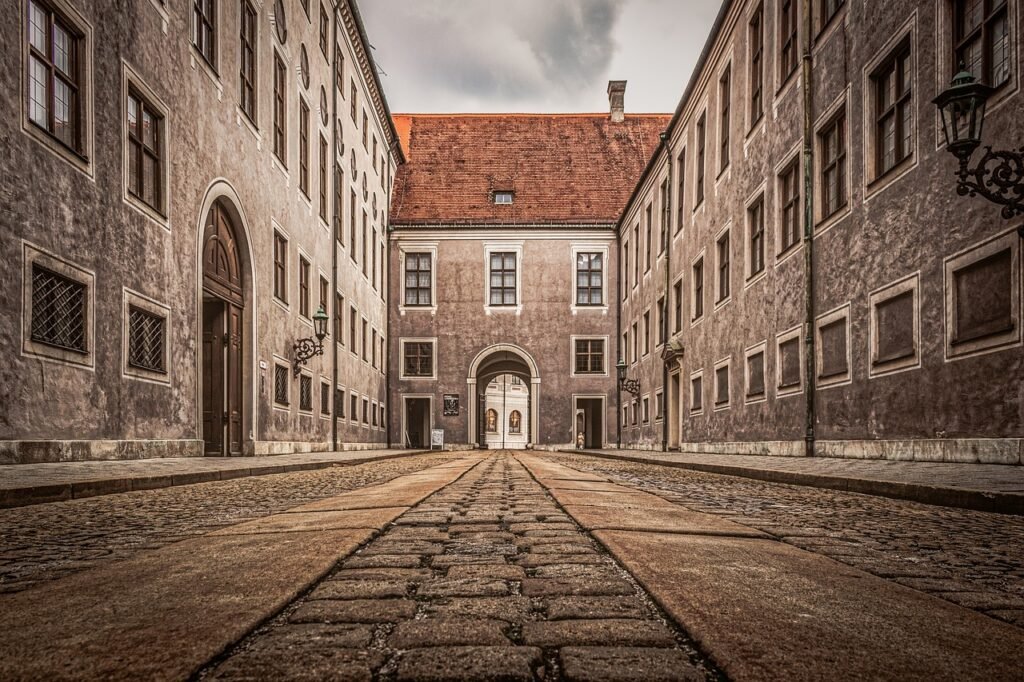
The neo-Gothic New Town Hall (Neues Rathaus) dominates the square, famous for its glockenspiel and serving as the location of both the Lord Mayor’s office and Tourist Information. During Advent, the Old Town hosts several Christmas markets, but the Christkindlmarkt at Marienplatz is the most traditional, dating back to the 14th century. It’s a must-see for visitors wanting to experience Munich’s holiday spirit.
7.Asam Church (Asamkirche)
Munich is full of hidden gems, and the Asam Church (Asamkirche) is one of the most surprising. Located on the bustling SendlingerStraße, this 18th-century church, officially named St.-Johann-Nepomuk-Kirche, is an unexpected masterpiece. Many visitors are drawn to its unique exterior and decide to peek inside, where they find a tiny church packed with enormous detail.
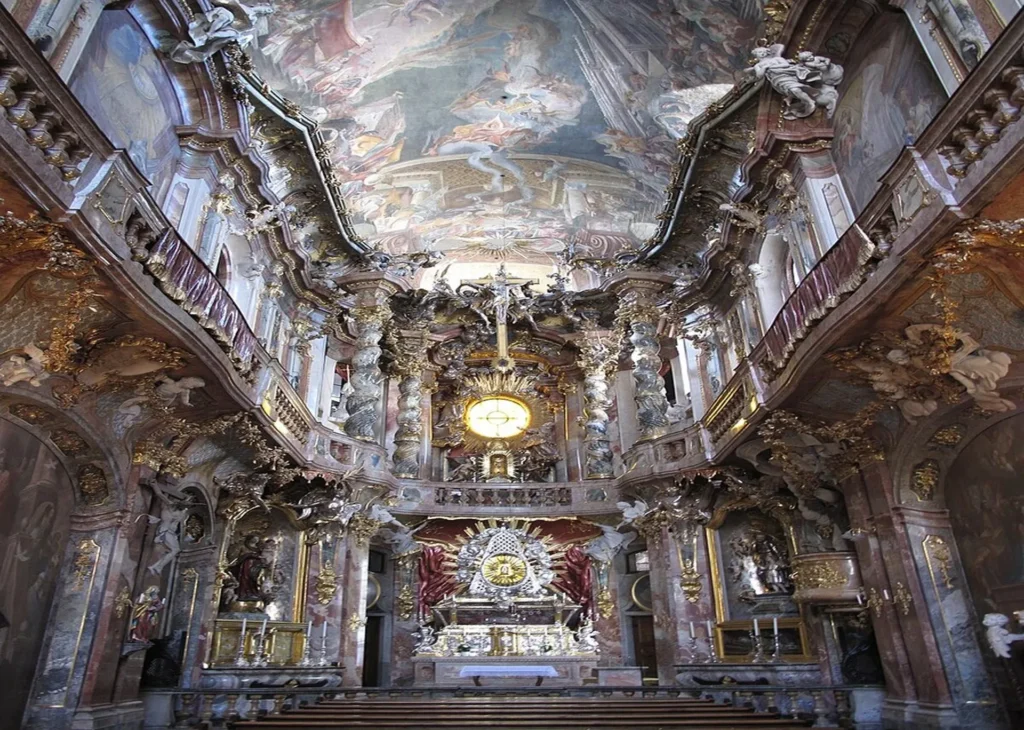
The church’s interior is nothing short of extravagant. Designed by the Asam brothers over 13 years, it features stunning Baroque style architecture, with ornate detail and vibrant rich color. One brother was a skilled sculptor and the other a talented painter, so the ceiling and walls are covered in breathtaking frescoes and statues. Despite its small size, with only 12 pews, the church dazzles visitors with its deep reds and golds, creating a truly magical atmosphere.
8. Glockenspiel in the New City Hall (Rathaus-Glockenspiel):
Located in the tower of the New City Hall (Neues Rathaus) on Marienplatz, Munich’s world-famous glockenspiel is a must-see. This solar-powered mechanical clock, featuring 43 bells and 32 life-size figures, first rang in 1908 and reenacts scenes from two famous 16th-century Munich stories. The performance occurs twice daily, with an additional reenactment at 5 p.m. from March to October. The glockenspiel plays a repertoire of 22 pieces of music, mostly folk songs, with four special pieces reserved for Advent. The only time it’s silent is on Good Friday.

Travelers often recommend the glockenspiel for its fun displays, but note that Marienplatz can get crowded at the scheduled times. It’s best to arrive early for a good viewing spot. Watching the glockenspiel is free, and the Marienplatz U-Bahn and S-Bahn stops are conveniently located nearby.
9.Pinakothek Museums
Alte Pinakothek
When visiting Munich, the Alte Pinakothek is a must-see. This museum, often referred to as the Old Picture Gallery, is home to some of the most significant works in European art history. Located in the Kunstareal district, it’s part of the BayerischeStaatsgemäldesammlungen, which houses several other museums worth exploring. Just a short walk from other museums, this collection stands out for its deep focus on European paintings from the 14th to 18th centuries. If you’re an art lover, the Old Picture Gallery offers a rich dive into masterpieces that have shaped art movements for centuries. I personally find it a peaceful spot, allowing visitors to reflect and admire art without the crowds seen in other places.
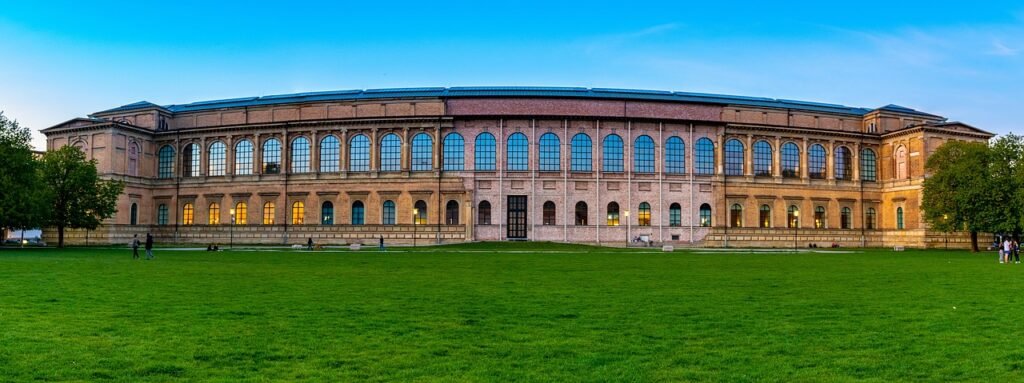
Neue Pinakothek
Another gem in Munich’s art district is the Neue Pinakothek or the New Picture Gallery. Opened in 1981, this museum replaced an earlier building destroyed during World War II. It focuses on 19th-century art, showcasing the works of famous German and European artists. The architecture itself is a beautiful blend of old and modern, making it an ideal destination for those interested in how contemporary and classical art converge. For anyone who has an interest in modern and romantic art, the Neue Pinakothek is the place to be. You’ll find it easy to lose track of time here, enjoying how art has evolved over centuries.
10.Deutsches Museum:
The Deutsches Museum is a science and technology hub like no other in the world. Spanning over 200,000 square feet, this expansive museum showcases exhibits on everything from robotics and aviation to bridges and musical instruments. After undergoing a major renovation that lasted for several years, the museum reopened in 2022, offering 19 new and redesigned exhibits. Whether you’re exploring the fascinating exhibits on cutting-edge technology or learning about the evolution of musical instruments, the museum offers something for everyone. A standout is the Kids’ Kingdom (Kinderreich), a special interactive section for young children, where they can enjoy exhibits like a marble run, a hall of mirrors, and even a giant guitar that they can crawl inside and play. The museum also features a rooftop restaurant for a relaxing break and a gift shop to pick up some unique memorabilia.
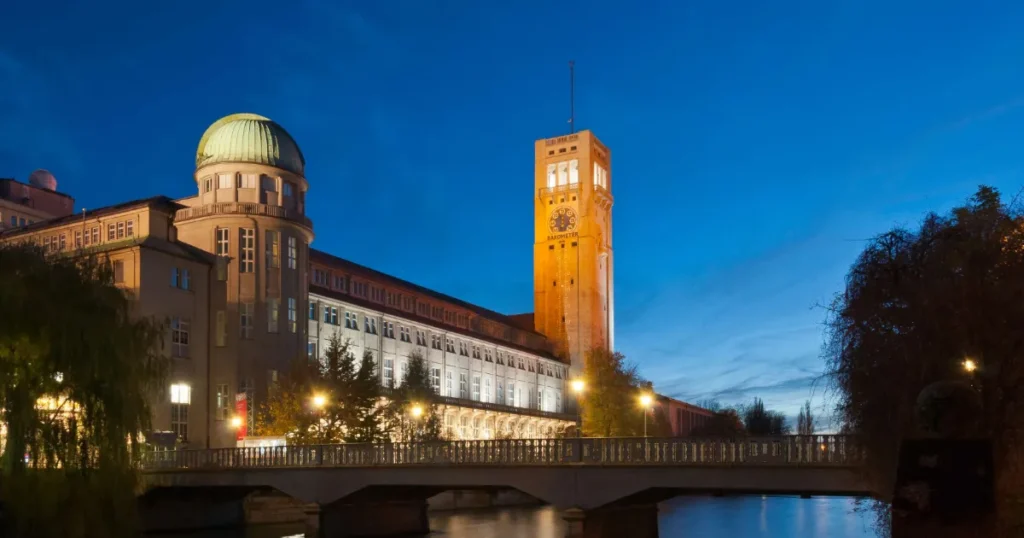
11. Olympiapark:
The park spans over 200 acres, making it impossible to see everything in one visit. For those with limited time, a 20-minute tram tour offers a quick yet comfortable way to explore the grounds for only 7 euros. While some visitors enjoy the convenience of the tour, others feel it could have included more interesting sights. For a stunning 360-degree view of the park, city, and the nearby Alps, take a hike up Olympic Hill (Olympiaberg), one of the highest elevations in the city and a popular picnic spot during the summer. During warm weather, you can also rent rowboats or pedal boats to enjoy a peaceful time on the park’s lake. If you’re a sports fan, don’t miss stadium tours, to know the inner workings of it, its unique architecture, and visit the VIP areas. And fun lovers there’s a chance to score a goal on the goal wall.
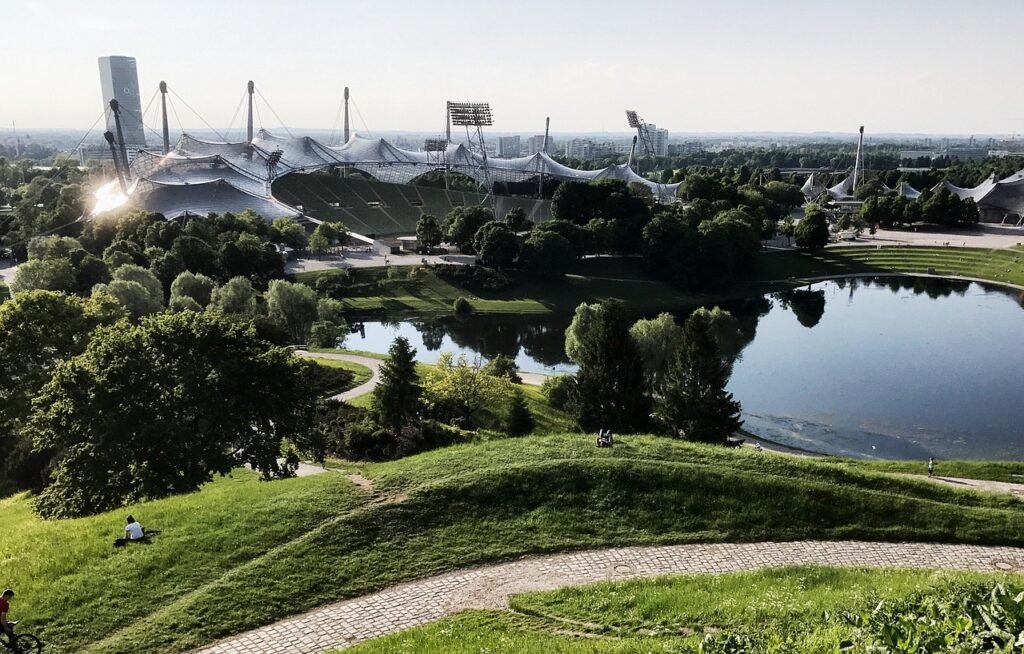
12. Augustiner-Keller
For an authentic Munich experience, visit Augustiner-Keller, one of the last remaining traditional beer gardens in the city center. As Munich’s oldest brewery, it holds a special place in the city’s history, having been first mentioned on the 1812 Munich city map as a beer storage facility. The beer garden, acquired by the Augustiner brewery in 1862, took its current form in 1896 and has remained largely unchanged since. With around 5,000 seats, it’s particularly popular in summer, thanks to the shade provided by its 100 chestnut trees. Guests can enjoy traditional Bavarian food like sausages and roast pork, or opt for lighter international dishes and salads. For a more budget-friendly option, follow the locals’ lead and bring a picnic. In winter, the historic brewery building offers a cozy retreat, with a network of warm rooms and larger beer halls where you can drink and dine in comfort.
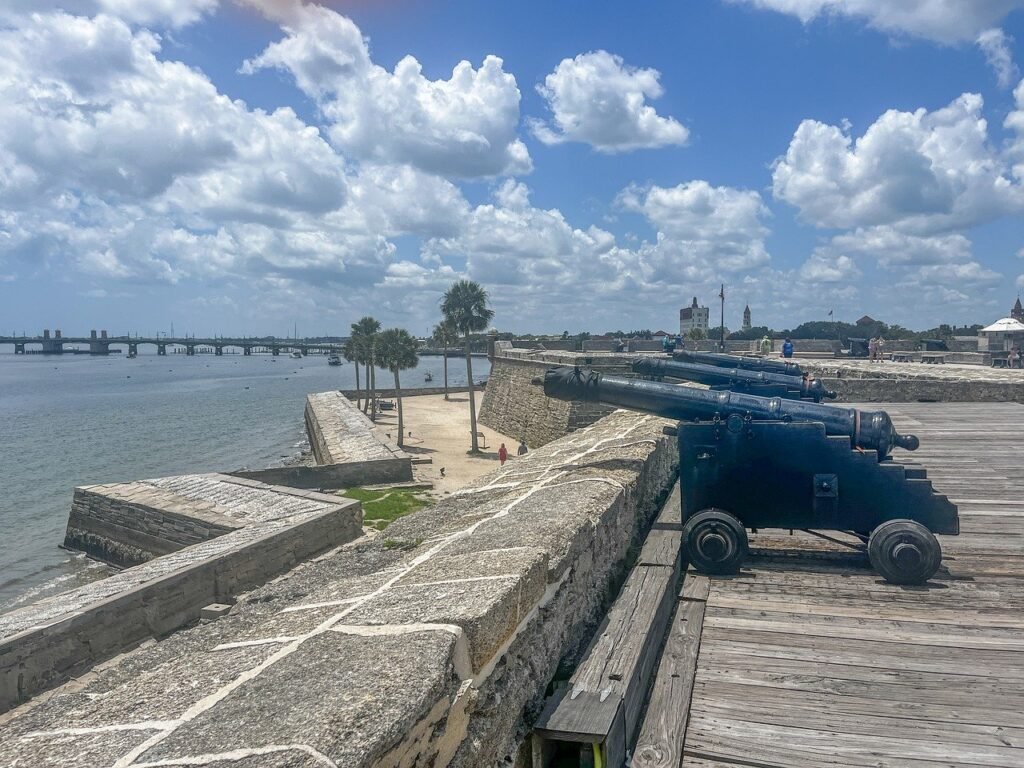
13. Odeonsplatz
The Field Marshals’ Hall (Feldherrnhalle), a striking three-arch monument built in the 1840s, is located at the south end of Odeonsplatz square. Its design closely resembles Florence’s Loggia dei Lanzi. Rich in pre-World War II history, it’s famously known as the site of the 1923 Beer Hall Putsch, a failed coup by the Nazi Party, which led to Hitler’s arrest. Today, the monument’s steps offer a relaxing spot where both Munich residents and visitors can sit back and enjoy the surroundings. In addition, the area above the steps serves as a stage for the annual Klassik Am Odeonsplatz, an open-air classical music festival held every July. If you’re in Munich during this time, be sure to grab a ticket to enjoy live music in the famed square.
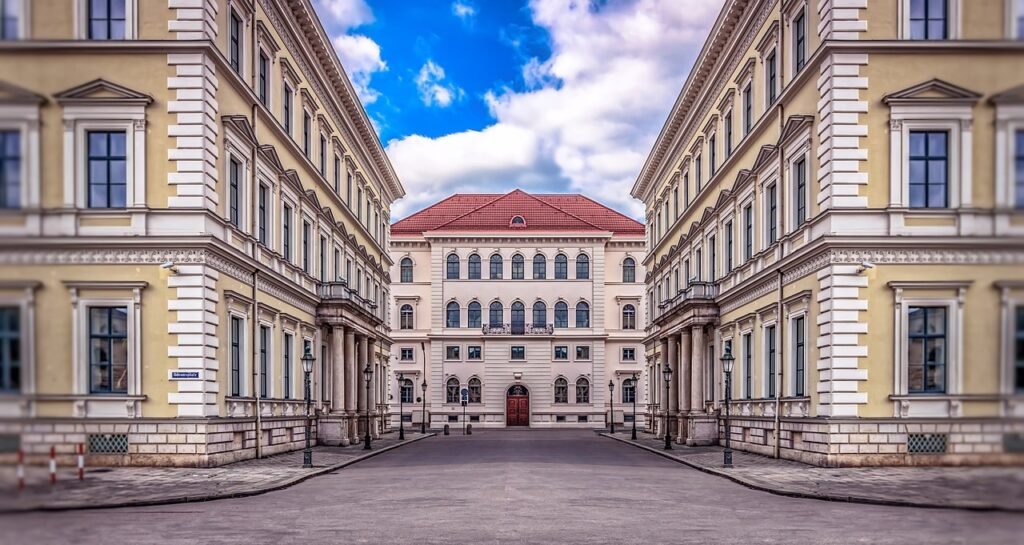
14. St. Peter’s Church (Peterskirche)
St. Peter’s Church (Peterskirche) is Munich’s oldest place of worship, and it offers a mesmerizing experience for visitors. The interior is beautifully decorated with white and gold, housing a variety of treasures. However, the real highlight is the church’s tower, affectionately known as Old Peter (Alter Peter) by locals. Standing at nearly 200 feet tall, the tower is adorned with eight clocks and eight bells. From its viewing platform, you can enjoy 360-degree views of Munich, including iconic landmarks like City Hall (Rathaus) and the Frauenkirche (Church of Our Dear Lady). Recent visitors have also been captivated by the church’s glittering altar and the impressive gold, jewel-bedecked, glass-enclosed skeleton of St. Munditia, a revered Christian martyr. The view from the tower is often described as a must-see and truly worth the climb.
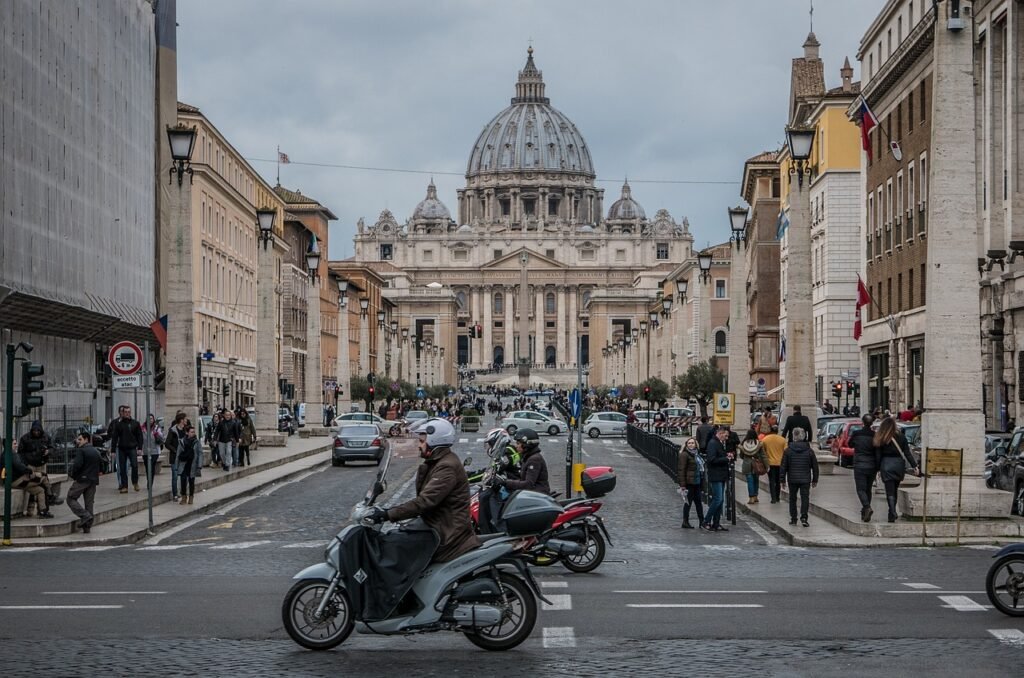
15.Cathedral of Our Dear Lady (Frauenkirche)
The Frauenkirche (officially called the Cathedral Of Our Dear Lady, or Zu UnsererLieben Frau) is one of Munich’s most iconic landmarks. Known locally as Munich Cathedral (Münchner Dom), this Gothic-period cathedral is easily recognizable by its distinctive dome-topped towers. Standing at around 323 feet, the dual towers are slightly unequal in height, and no one is quite sure why. Thanks to a law passed in 2004, no buildings within Munich city limits can be constructed taller than these towers. The main part of the church and the two towers were built in the late 1400s using red bricks, as there were no local stone quarries. The domed tower roofs were added in 1525. While the cathedral was heavily damaged during World War II bombing, it was restored with a simpler design at first, later receiving more ornate embellishments to match its original grandeur.
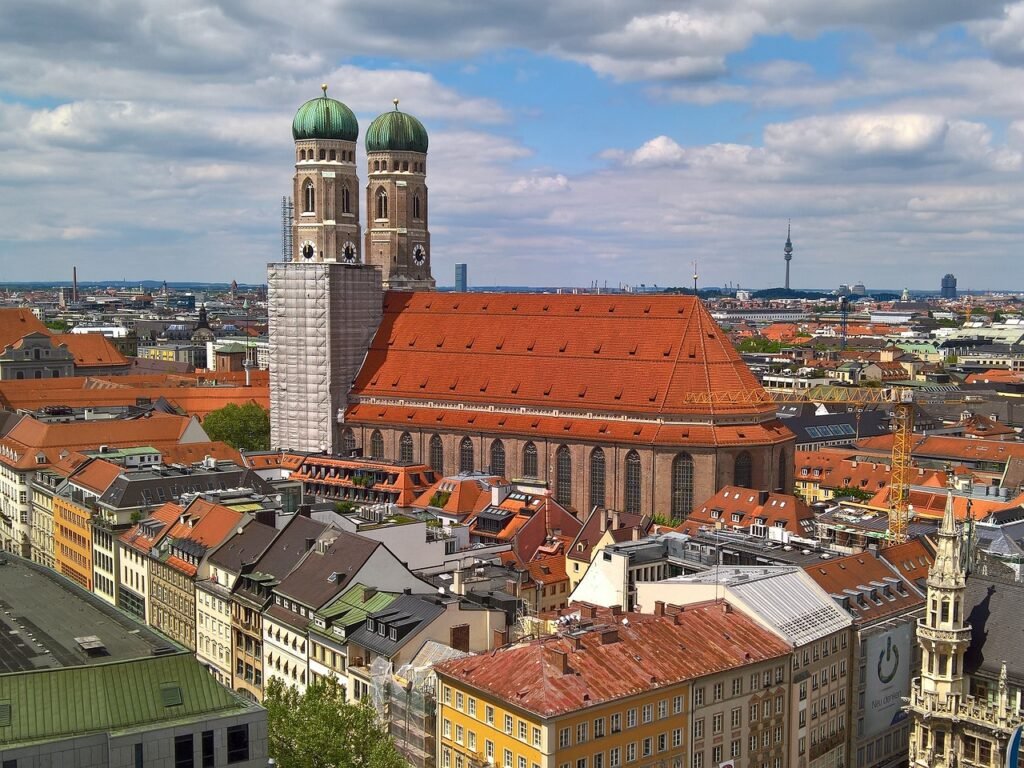
16.Neuschwanstein Castle (Schloss Neuschwanstein):
Neuschwanstein Castle (Schloss Neuschwanstein) is one of Europe’s most famous landmarks, and it even inspired Disneyland’s Sleeping Beauty Castle. Built on a rock ledge above the Pöllat Gorge in the medieval-style, the castle was commissioned by King Ludwig II in 1868, sitting on the site of two smaller castles. Today, it’s a must-see tourist destination, located just a two-hour train ride south of Munich. Even if you’re not interested in touring the inside of the castle, the exterior views and surrounding scenery are more than worth the trip. Visitors can enjoy the photogenic setting from one of the many wooded trails or from Marienbrücke, a bridge suspended over a waterfall offering spectacular photo-ops of the castle with the backdrop of the Bavarian Alps
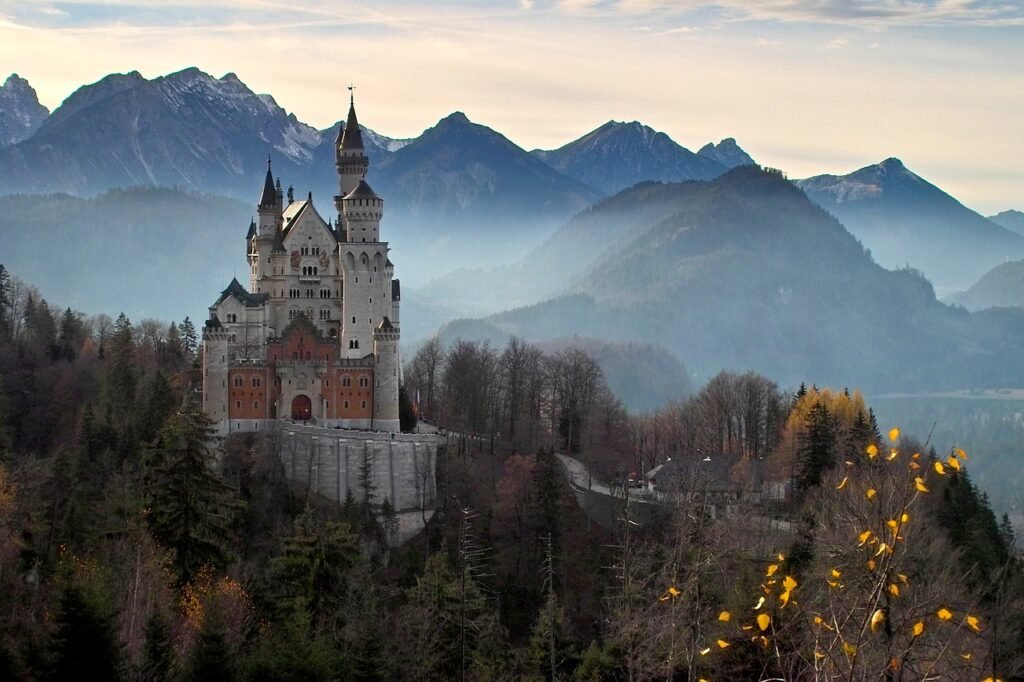
17.Bavarian National Museum (BayerischesNationalmuseum)
Founded in 1855 by King Maximilian II, the Bavarian National Museum showcases the history of the Wittelsbach dynasty and the people they ruled. Initially located between Karlsplatz and Marienplatz, the museum soon outgrew its original space and was relocated in 1900 to a historic building complex on Prinzregentenstraße, near the River Isar. After being severely damaged during World War II, the museum underwent extensive reconstruction. Its permanent collection includes a rich variety of artworks collected by the Wittelsbach family, featuring paintings, sculptures, decorative clocks, costumes, and ivory carvings, spanning from the Middle Ages to the Renaissance, baroque, rococo, and art nouveau periods. One of the highlights is its impressive collection of nativity scenes, which provide insight into their cultural history from the 17th to the 20th century, including a lifelike 18th-century Neapolitan nativity scene and Moravian nativity scenes made from pape
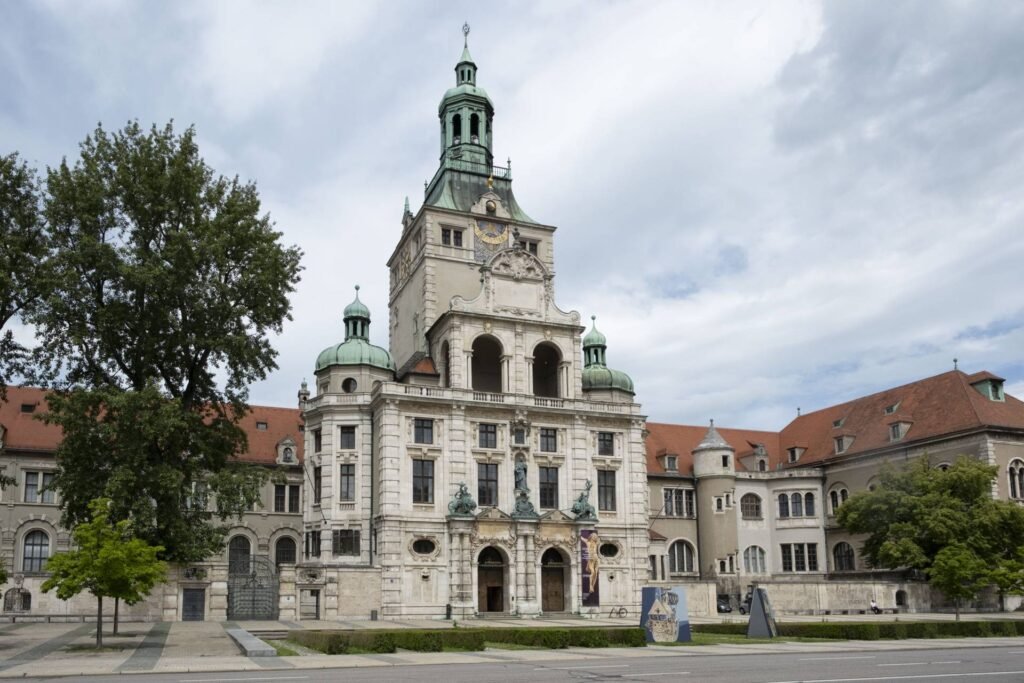
18.The Hirschgarten
Situated in the Nymphenburg district in Munich, the Hirschgarten park spans around 100 acres and was created in 1780 by Elector Carl Theodor as a hunting ground for the nobility. While no longer used for hunting, the park is home to a wild animal enclosure with fallow deer and wild sheep that visitors can feed, following the signage on what the animals can eat. The park also features several playgrounds, including a water playground, a small skate park, barbeque areas, and various walking trails. The KöniglicherHirschgarten restaurant and beer garden, established in 1791, is the largest traditional beer garden in the world, with seating for over 8,000 people. Visitors can enjoy classic Bavarian dishes like white sausages, käsepätzle, and a platter of bread, cold cuts, and cheeses, all while enjoying the park’s ambiance, excellent service, and a peaceful atmosphere away from the busy downtown.
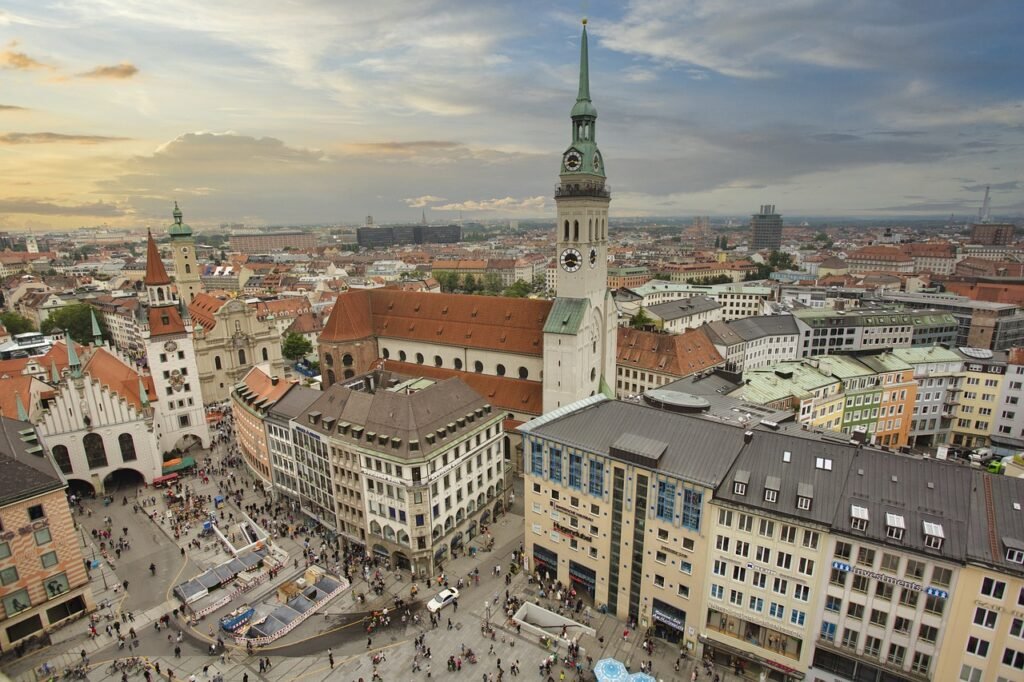
19.St. Michael’s Church (Michaelskirche)
Located in Munich’s pedestrian zone between Karlsplatz and Marienplatz, St. Michael’s Church (Michaelskirche) is considered the first Renaissance church built north of the Alps. Commissioned by Duke Herzog Wilhelm V, the Jesuit church was modeled after the Jesuits’ mother church in Rome. The church’s foundation stone was laid in 1583, but due to an unstable vaulting system, the tower collapsed in 1590, destroying the newly completed choir. A second phase of construction expanded the original plans, resulting in the towerless church we see today, with a new choir and transept, creating an impressively proportioned building. Many travelers consider it a must-see in Munich.
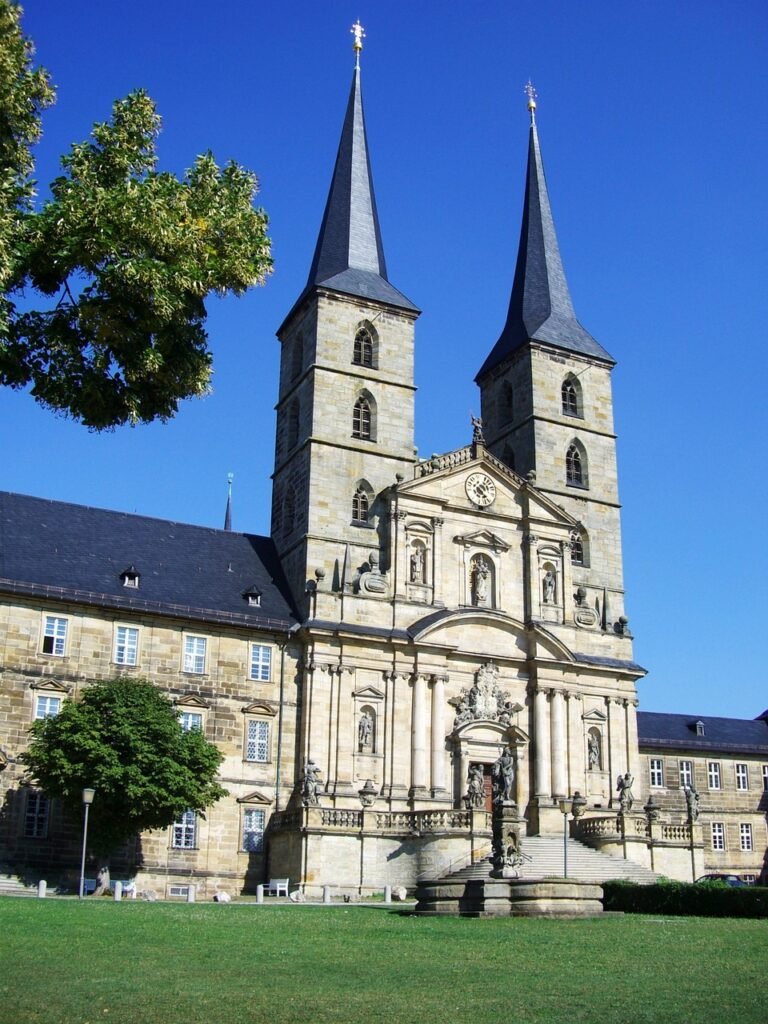
20. Cuvilliés Theatre (Cuvilliés-Theater):
Named after its Belgian-born architect François de Cuvilliés, the Cuvilliés Theatre (originally called the Residence Theatre or Residenztheater) was built in rococo style in the mid-18th century for Elector Maximilian Joseph III. The theatre was designed for grand opera performances for the royal court. Unfortunately, it was destroyed near the end of World War II, but was rebuilt in one of the wings of the Munich Residence (Residenz München). During the war, the ornately carved wooden box paneling was dismantled, stored, and later reused in its meticulous reconstruction. The theatre, decorated in magnificent red and gold, reopened in 1958 under its new name, the Cuvilliés Theatre. To distinguish it from the New Residence Theatre (NeuesResidenztheater), it’s also known as the Old Residence Theatre (Altes Residenztheater), built on its original site.
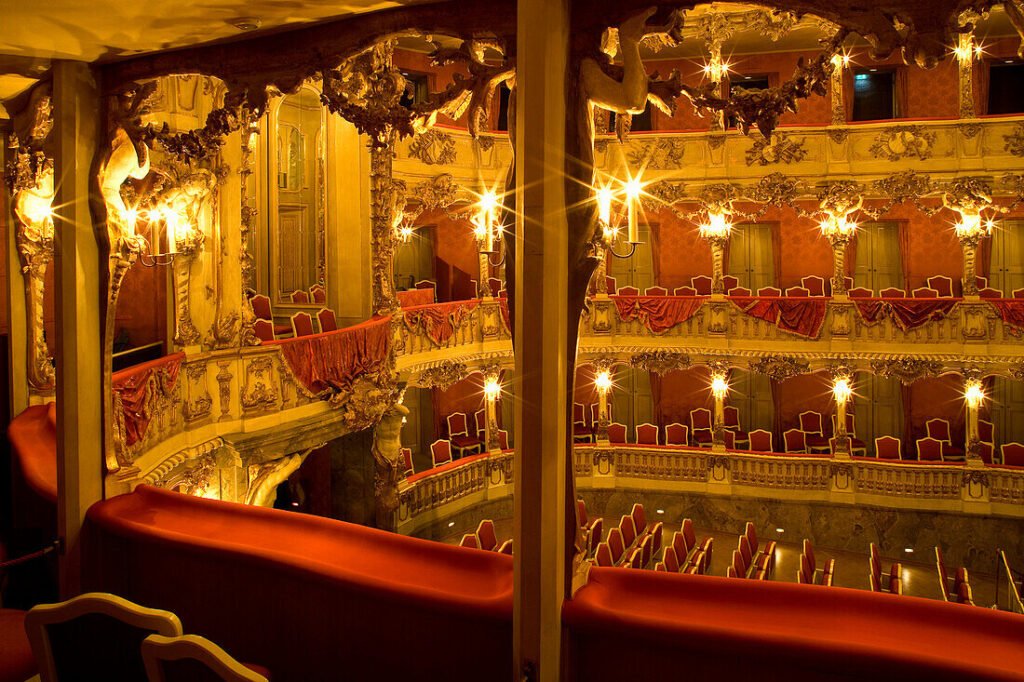
21. NS-Dokumentationszentrum:
The Museum of National Socialism is located on Königsplatz, where the Brown House (Braunes Haus) once stood, the former headquarters of the Nazi Party (National Socialist German Workers’ Party), which was nearly destroyed by Allied bombing in 1945. Between 1933 and 1945, this area, surrounding the nsdoku, was central to the rise of National Socialism in Munich and housed many of the Nazi Party’s administrative offices. The museum offers a mix of permanent and temporary exhibitions, events, and educational programs that explore the dark history of antisemitism, genocide, racism, and displacement. The museum’s permanent exhibition, “Munich and Nationalism Socialism,” spans four floors and documents the origins and lasting effects of National Socialism. In the basement, the Learning Center provides media tables and research terminals, offering deeper insights into this critical historical period.
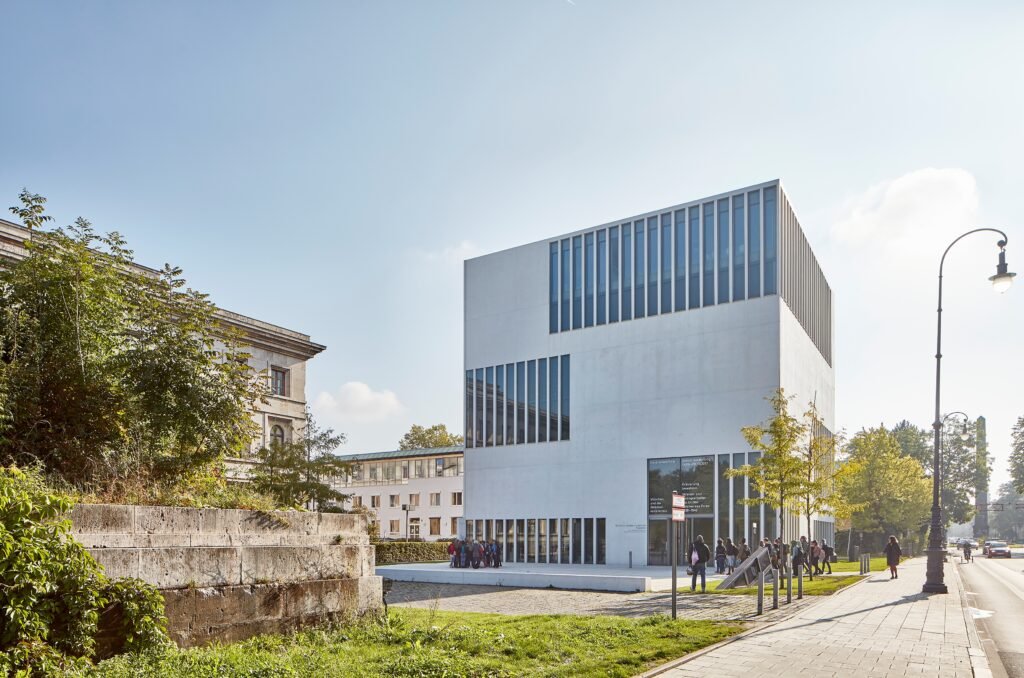
22.Munich Court Garden (Hofgarten):
The Munich Court Garden (Hofgarten) is a peaceful area bordered by the Munich Residence (Residenz München), the Bavarian State Chancellery (BayerischeStaatskanzlei), and Odeonsplatz. It’s a great place to stroll and take a break from sightseeing and shopping, with plenty of benches to relax on. Plans for the garden date back to 1613, when new buildings and extensions to the palace were being constructed. Designed in the style of formal Italian Renaissance gardens, the garden was redesigned several times to match changing fashions. It was later rebuilt after being destroyed during World War II
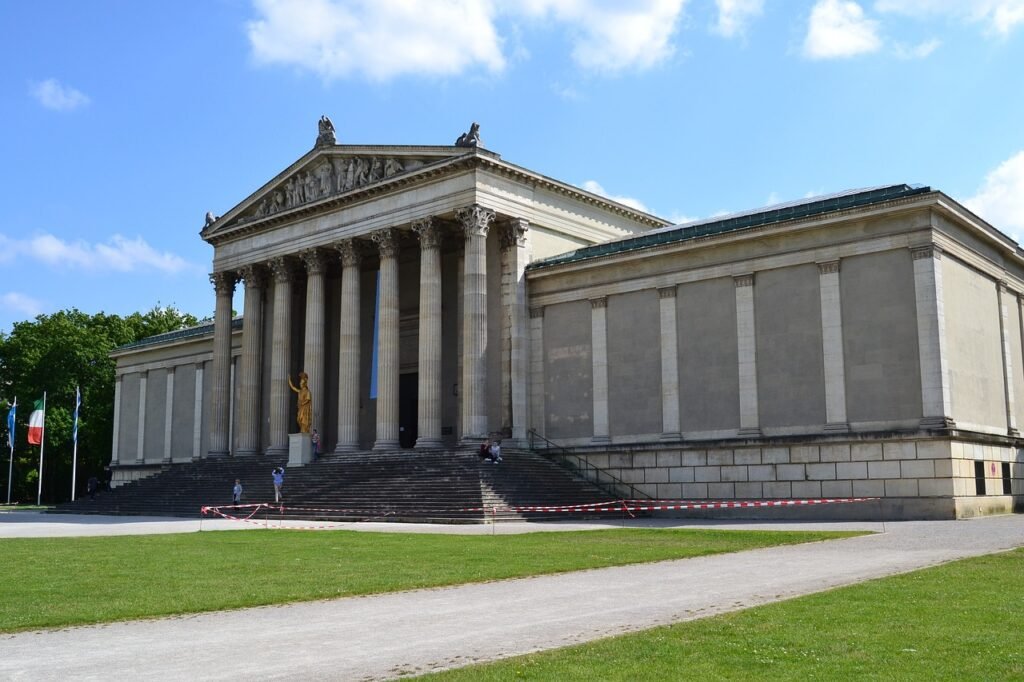
23.Bavarian State Opera House
If your Munich visit coincides with the opera’s annual summer festival, consider attending a free live broadcast from the National Theatre or an open-air concert at Max-Joseph-Platz. Like the locals, bring a picnic and something to sit on. The Bavarian State Opera (BayerischeStaatsoper) is one of the world’s most acclaimed opera houses, with a history spanning 350 years. Today, it boasts its own orchestra (Bavarian State Opera, BayerischeStaatsorchester) and ballet company (Bavarian State Ballet, BayerischeStaatsballett). The main performance venue, the neoclassical National Theater (Nationaltheater), first opened in 1818 and houses one of the world’s largest stages at nearly 27,000 square feet. The company also performs at the Cuvilliés Theater (Cuvilliés-Theater) at the Munich Residence (Residenz) and the Prince Regent Theater (Prinzregententheater) in the Bogenhausen district.

24.Bavarian State Opera House (BayerischeStaatsoper)
During your Munich visit, if the timing coincides with the opera’s annual summer festival, don’t miss the chance to enjoy a free live broadcast from the National Theatre or attend an open-air concert at Max-Joseph-Platz. Follow the locals’ tradition by bringing a picnic and something to sit on. The Bavarian State Opera (BayerischeStaatsoper) is among the world’s most acclaimed opera houses, with a history of over 350 years. It has its own orchestra, the Bavarian State Opera (BayerischeStaatsorchester), and ballet company, the Bavarian State Ballet (BayerischeStaatsballett). The main venue, the neoclassical National Theater (Nationaltheater), opened in 1818 and boasts one of the world’s largest stages at nearly 27,000 square feet. The company also performs at the Cuvilliés Theater (Cuvilliés-Theater) at the Munich Residence (Residenz) and the Prince Regent Theater (Prinzregententheater) in Bogenhausen district.
25.Visit the Hellabrunn Zoo
For any zoo enthusiast, the Hellabrunn Zoo in Munich is a must-visit. It’s known as one of the largest zoos in Europe and stands out as the world’s first geo-zoo, where animals are grouped by their geographic habitats rather than species. With over 19,000 animals representing 700 species, it offers a truly fascinating experience. Whether you’re exploring the diverse habitats or discovering new species, Hellabrunn Zoo provides an exciting adventure for all animal lovers.
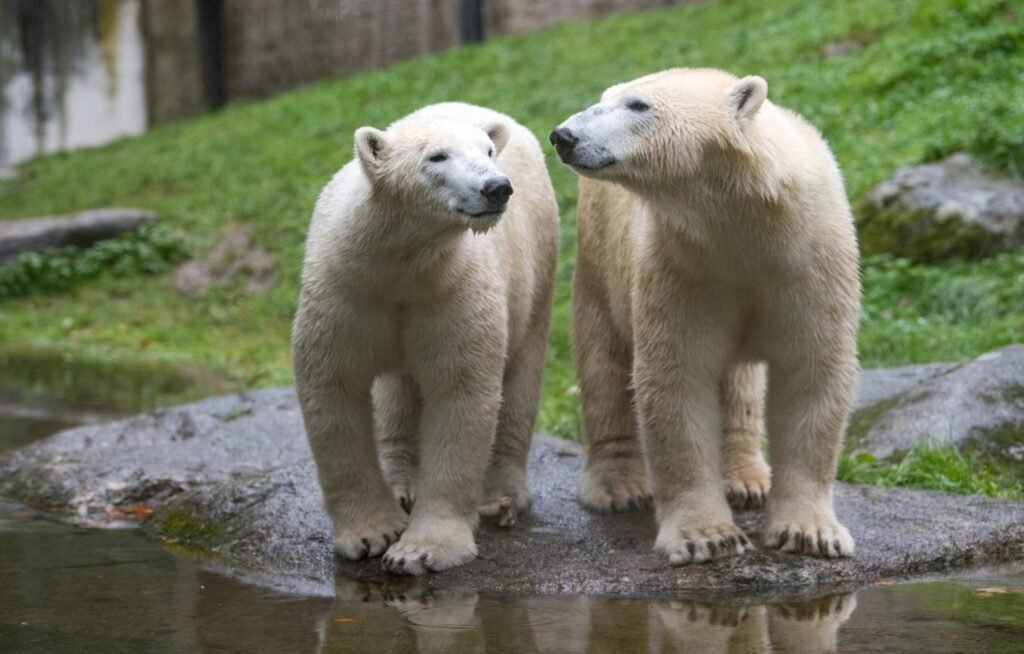
26.Haus der Kunst:
Nestled beside the picturesque Englischer Garten, Haus der Kunst in Munich stands as an imposing sight among the city’s many art galleries. This interdisciplinary space showcases the best of contemporary art, though its neoclassical building has a complex history, originally constructed in 1937 to house Nazi-approved art. Today, the Kunst regularly confronts its propagandist heritage, creating a thought-provoking experience. After your visit, unwind at the adjoining Goldene Bar, known for its vibrant cocktails like the Goldene Bartini—a refreshing blend of gin, Lillet Blanc, and lemon—in a sleek and shiny setting.
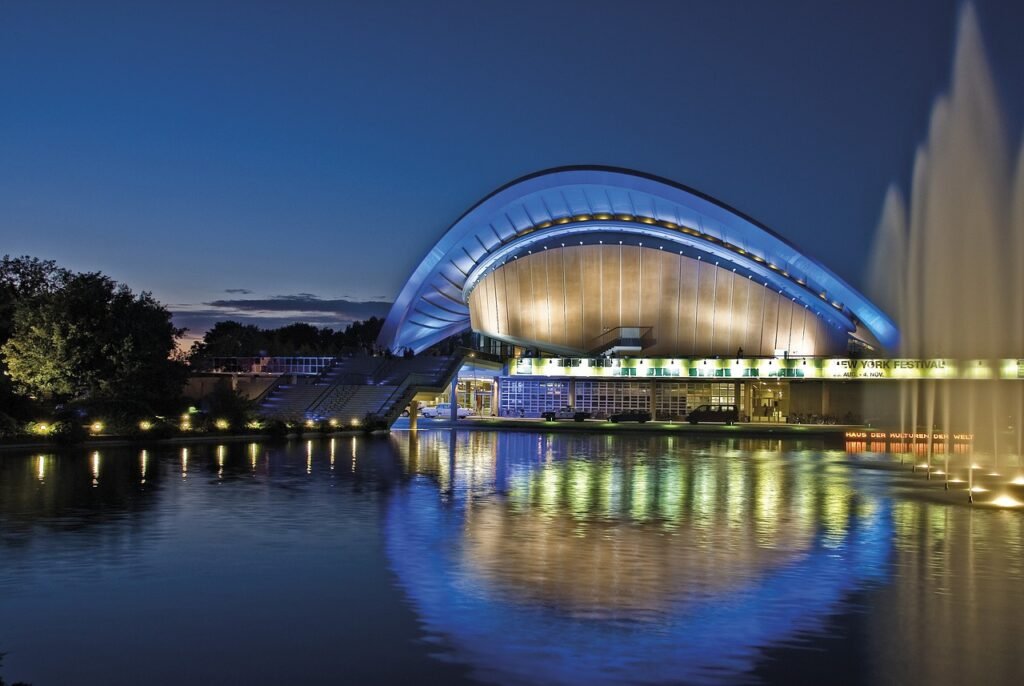
27. Siegestor:
The Siegestor in Munich, resembling a smaller Brandenburg Gate, is a triple-arched monument to victory and a poignant reminder to peace. Commissioned by King Ludwig I in the 1850s, it was inspired by the ancient Roman Arch of Constantine. However, the monument endured extensive damage during the Second World War, leading to a 30-year restoration that included the quadriga of Bavaria and her four lions. To experience it firsthand, head to where Ludwigstrasse meets Leopoldstrasse. While the ornate frontage offers a visual wonder, the blank back makes a powerful statement about what war takes away, inscribed with the words: “Dem Sieg geweiht, von Krieg zersört, zum Frieden mahnend” (Dedicated to victory, destroyed by war, urging peace).
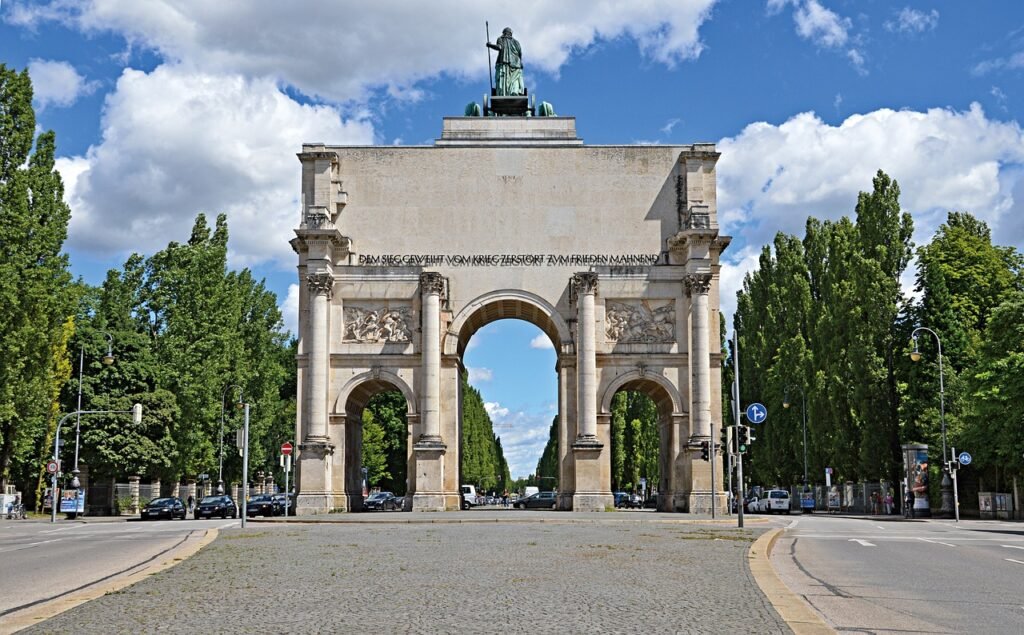
28.Die Pinakotheken:
Across from the Brandhorst Museum, Munich’s Pinakothek trio—the Alte Pinakothek, Neue Pinakothek, and Pinakothek der Moderne—spans European art history from the Middle Ages to the present day in blockbuster style. At the Alte Pinakothek, Albrecht Dürer’s Self-Portrait with Fur-Trimmed Robe stands out, with its Christ-like gaze and textural richness. There are also many other treasures to explore, including the Pinakothek der Moderne, which showcases the works of Blaue Reiter, Munich’s very own Expressionist movement.

29. Kunstfoyer der Bayerischen
In an unassuming building by Maximiliansbrücke, the Kunstfoyer VKB maintains a lower profile compared to the prominent museums of the Kunstareal enclave, yet it’s a must-visit for those into video art or photography. Focusing on socially and politically minded artists and the interplay of still and moving pictures, past exhibitions have featured legends like Gordon Parks, Margaret Bourke-White, Sebastião Salgado, and Ken Adam (known for his iconic set designs in Bond films and Kubrick classics). Visitors are also treated to stunning views of the Maximilaneum, one of Munich’s most palatial buildings, often regarded as the most magnificent student residence.

30. Dachau Concentration Camp Memorial
Maximize your time in Munich with a private guided tour that covers the main sights, including a visit to the Dachau Concentration Camp Memorial. Begin your experience with hotel pickup by a knowledgeable local tour guide and enjoy the comfort of an air-conditioned car. Your driver and tour guide will meet you at your selected pickup location, giving you an introduction to Germany and Munich’s recent history. With a separate driver, your tour guide can concentrate fully on explaining each area, customizing your route, and ensuring you have the option to stop and walk around at any location that piques your interest.
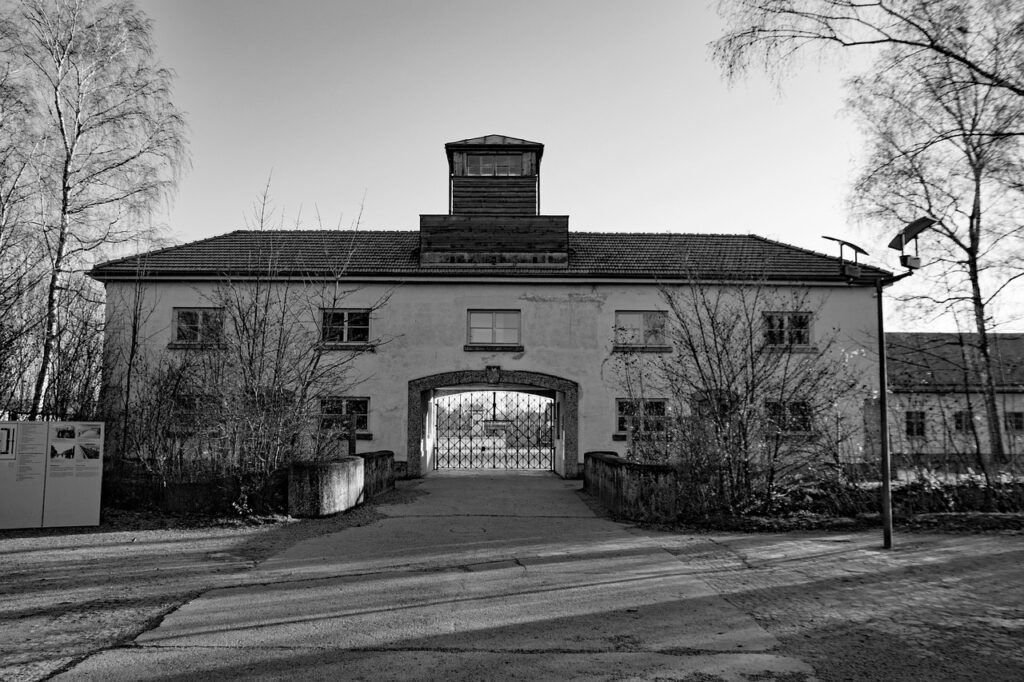
Top Activities to do in Munich:
1.Christmas market hopping with a sightseeing tour
- Experience the magic of Christmas market hopping by visiting Marienplatz, Viktualienmarkt, and the Residence Hofgarten, each offering unique holiday charm.
- Take a sightseeing tour that showcases Munich’s festive spirit and historic landmarks, immersing you in the city’s holiday atmosphere.
2.Birthplace of the Third Reich Guided Walking Tour
- Explore Munich’s dark past and the rise of the Third Reich.
- Visit the beer halls where Hitler held his first party meetings and speeches.
- Stand at the location where Goebbels orchestrated the Night of Broken Glass.
- Discover how the Nazi Party and its ideology gained power in Munich.
- Pay tribute at the monuments dedicated to the victims and opponents of Nazism.
3. FC Bayern Munich Allianz Arena Tour
- Experience the Allianz Arena Tour and explore its iconic stadium.
- Immerse yourself in the history and highlights of the FC Bayern Museum.
- Shop for exclusive FC Bayern merchandise at the fans’ shop.
- Visit the training grounds and see where the team prepares.
- Discover the city of Munich with a guided bus tour.
4.Witches and Executioners Dark History Walking Tour
- Uncover Munich’s mysterious past by visiting places that once inspired fear.
- Hear tales of lost souls—witches, executioners, and outcasts.
- Learn about the deceptive professions of the Middle Ages.
- Delve into the city’s dark secrets and untold stories.
5. Night PubCrawl Shots and Party:
- Embark on a lively bar crawl through Munich’s nightlife.
- Enjoy the company of a local guide who knows the best spots.
- Savor shots at each location along the way.
- Gain exclusive club entry as part of the experience.
- Start the fun with shots at the meeting point.
- Additional drinks available throughout the tour.
- Explore the city with a guided tour showcasing its highlights.
FAQs:
What are the must-see historical sites in Munich?
Must-see historical sites include the Nymphenburg Palace, the Hofbräuhaus beer hall, the Dachau Concentration Camp Memorial, and the places where Hitler held his first speeches.
Can I visit the FC Bayern Munich Allianz Arena without a game ticket?
yes, you can take the Allianz Arena Tour, visit the FC Bayern Museum, browse the fan shop, and see the training grounds even if you don’t have a match ticket.
What is the best time of year to visit Munich’s Christmas markets?
The Christmas markets in Munich are best experienced from late November to December, with the largest markets at Marienplatz and Viktualienmarkt offering festive food, crafts, and decorations.
What can I expect from a night out on a Munich bar crawl?
A Munich bar crawl includes visiting several bars, enjoying shots at each location, club entry, and additional drinks, along with a guided city tour of Munich’s nightlife hotspots.
What are some family-friendly activities in Munich?
Families can enjoy the Hellabrunn Zoo, the Deutsches Museum’s kids’ section, and outdoor activities in the English Garden, as well as boat rentals in the summer.
Is Munich a good city for art lovers?
Yes, Munich boasts several world-class art museums, including the Alte Pinakothek, Neue Pinakothek, and Pinakothek der Moderne, showcasing works from the Middle Ages to modern art movements like Expressionism.
How can I learn about Munich’s dark history?
Guided tours focusing on Munich’s Nazi past, such as visiting Hitler’s first meeting place and the site of the Night of Broken Glass, are available. Also, check out the Documentation Centre Nazi Party Rally Grounds.
What is the best way to explore Munich on a budget?
Walking tours, public transportation, and visits to free sites like the English Garden and the Hofgarten can provide an affordable way to explore Munich, alongside free live music events in summer.
Can I visit the monuments that honor victims of Nazism in Munich?
Yes, Munich has several monuments dedicated to the victims of the Nazi regime, such as the Memorial to the Victims of National Socialism and the Residenz Memorial.
What makes the Hellabrunn Zoo different from other zoos?
Hellabrunn Zoo is the world’s first geo-zoo, where animals are grouped by their geographic habitats rather than species, and it’s home to over 19,000 animals from 700 species across various habitats.
Conclusion:
Munich offers an incredible variety of experiences that cater to all types of visitors, from history buffs and art lovers to nightlife enthusiasts and thrill-seekers. Whether you’re delving into the city’s darker past on a historical tour, exploring the world-renowned art galleries, or getting a taste of Bavaria’s rich culture at local beer gardens and markets, there’s always something exciting around every corner. Sports fans can immerse themselves in the passion of FC Bayern Munich at the Allianz Arena, while those interested in the city’s more mysterious side can uncover chilling tales of witches and executioners on a guided ghost tour. Munich’s dynamic nightlife scene, with its famous bar crawls and club entries, promises unforgettable nights out. No matter your interests, Munich seamlessly blends its vibrant past with modern-day attractions, making it a must-visit destination for every traveler.

